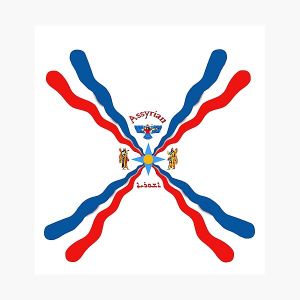Difference between revisions of "Language/Assyrian-neo-aramaic/Vocabulary/Colors"
m (Quick edit) |
|||
| (3 intermediate revisions by one other user not shown) | |||
| Line 1: | Line 1: | ||
{{Assyrian-neo-aramaic-Page-Top}} | {{Assyrian-neo-aramaic-Page-Top}} | ||
<div class="pg_page_title">Assyrian Neo-Aramaic - Colors</div> | |||
In | <div class="pg_page_title">Assyrian Neo-Aramaic Vocabulary - Colors</div> | ||
Hi [https://polyglotclub.com/language/assyrian-neo-aramaic Assyrian Neo-Aramaic] learners! 😊<br>In this lesson, we will be learning about colors in Assyrian Neo-Aramaic, which is essential to everyday conversations. We will provide cultural and interesting facts to help you remember and understand these words. Don't forget to practice with a native speaker on [https://polyglotclub.com/find-friends.php?search=send&d=0&f=36&offre1=9 Polyglot Club] and ask them any [https://polyglotclub.com/language/assyrian-neo-aramaic/question questions]. Let's begin! | |||
__TOC__ | __TOC__ | ||
== | == Basic Colors == | ||
In Assyrian Neo-Aramaic, the word for color is "rango," with the plural form being "rangye." Here are the most basic colors: | |||
{| class="wikitable" | {| class="wikitable" | ||
! Assyrian Neo-Aramaic !! Pronunciation !! English | |||
|- | |||
| ܟܘܼܡܵܐ || kouma || Black | |||
|- | |- | ||
| ܚܒ̣ܵܪܵܐ || khwara || White | |||
|- | |- | ||
| | | ܣܡܘܼܩܵܐ || smouqa || Red | ||
|- | |- | ||
| | | ܡܝܼܠܵܐ || mila(na) || Blue | ||
|- | |- | ||
| | | ܩܝܼܢܵܐ || qina || Green | ||
|- | |- | ||
| | | ܐܸܛܪܘܼܓܼܵܐ || etrougha || Orange | ||
|- | |- | ||
| | | ܐܲܪܓܘܵܢܵܐ(ܒܹܢܵܦ̣ܫܵܐ) || argwana (benawsha) || Purple | ||
|- | |- | ||
| | | ܫܲܚܡܵܝܵܐ (ܩܲܗܘܵܝܵܐ) || shakhmaya (qahwaya) || Brown | ||
|} | |} | ||
== | Fun Fact: Assyrians are known for their love of the color blue. Blue is used in traditional Assyrian clothing, as well as in architecture and art. It is said that the ancient Assyrian Empire used blue pigment to color the brick walls of their palaces and temples to represent heaven. | ||
== Conclusion == | |||
Congratulations! You have learned some of the most important colors in Assyrian Neo-Aramaic. Remember to practice with a native speaker on [https://polyglotclub.com/find-friends.php?search=send&d=0&f=36&offre1=9 Polyglot Club] and use these words in context to help reinforce your learning. If you want to improve your [https://polyglotclub.com/language/assyrian-neo-aramaic/vocabulary Vocabulary] further, check out some of our other lessons on [[:Language/Assyrian-neo-aramaic|Assyrian Neo-Aramaic]]! 😊 | |||
<hr>➡ If you have any questions, please ask them in the comments section below.<br>➡ Feel free to edit this wiki page if you think it can be improved. 😎 | |||
== | |||
<span link>Upon wrapping up this lesson, take a look at these related pages: [[Language/Assyrian-neo-aramaic/Vocabulary/Feelings-and-Emotions|Feelings and Emotions]], [[Language/Assyrian-neo-aramaic/Vocabulary/Food|Food]], [[Language/Assyrian-neo-aramaic/Vocabulary/Education|Education]] & [[Language/Assyrian-neo-aramaic/Vocabulary/Drinks|Drinks]].</span> | |||
{{#seo: | |||
|title=Assyrian Neo-Aramaic Vocabulary - Colors | |||
|keywords=Assyrian Neo-Aramaic, colors, vocabulary, basic colors, additional colors | |||
|description=In this lesson, you will learn the basic and additional colors in Assyrian Neo-Aramaic. Get cultural and interesting facts to help you learn better! | |||
}} | |||
==Other Lessons== | |||
* [[Language/Assyrian-neo-aramaic/Vocabulary/Count-to-10|Count to 10]] | |||
* [[Language/Assyrian-neo-aramaic/Vocabulary/Days-of-the-Week|Days of the Week]] | |||
* [[Language/Assyrian-neo-aramaic/Vocabulary/Clothes|Clothes]] | |||
* [[Language/Assyrian-neo-aramaic/Vocabulary/Geography|Geography]] | |||
* [[Language/Assyrian-neo-aramaic/Vocabulary/Fruits|Fruits]] | |||
* [[Language/Assyrian-neo-aramaic/Vocabulary/Days-of-the-week|Days of the week]] | |||
* [[Language/Assyrian-neo-aramaic/Vocabulary/Drinks|Drinks]] | |||
* [[Language/Assyrian-neo-aramaic/Vocabulary/Education|Education]] | |||
* [[Language/Assyrian-neo-aramaic/Vocabulary/Food|Food]] | |||
* [[Language/Assyrian-neo-aramaic/Vocabulary/Months-of-the-year|Months of the year]] | * [[Language/Assyrian-neo-aramaic/Vocabulary/Months-of-the-year|Months of the year]] | ||
{{Assyrian-neo-aramaic-Page-Bottom}} | {{Assyrian-neo-aramaic-Page-Bottom}} | ||
<span links></span> | |||
Latest revision as of 23:49, 11 January 2024
Hi Assyrian Neo-Aramaic learners! 😊
In this lesson, we will be learning about colors in Assyrian Neo-Aramaic, which is essential to everyday conversations. We will provide cultural and interesting facts to help you remember and understand these words. Don't forget to practice with a native speaker on Polyglot Club and ask them any questions. Let's begin!
Basic Colors[edit | edit source]
In Assyrian Neo-Aramaic, the word for color is "rango," with the plural form being "rangye." Here are the most basic colors:
| Assyrian Neo-Aramaic | Pronunciation | English |
|---|---|---|
| ܟܘܼܡܵܐ | kouma | Black |
| ܚܒ̣ܵܪܵܐ | khwara | White |
| ܣܡܘܼܩܵܐ | smouqa | Red |
| ܡܝܼܠܵܐ | mila(na) | Blue |
| ܩܝܼܢܵܐ | qina | Green |
| ܐܸܛܪܘܼܓܼܵܐ | etrougha | Orange |
| ܐܲܪܓܘܵܢܵܐ(ܒܹܢܵܦ̣ܫܵܐ) | argwana (benawsha) | Purple |
| ܫܲܚܡܵܝܵܐ (ܩܲܗܘܵܝܵܐ) | shakhmaya (qahwaya) | Brown |
Fun Fact: Assyrians are known for their love of the color blue. Blue is used in traditional Assyrian clothing, as well as in architecture and art. It is said that the ancient Assyrian Empire used blue pigment to color the brick walls of their palaces and temples to represent heaven.
Conclusion[edit | edit source]
Congratulations! You have learned some of the most important colors in Assyrian Neo-Aramaic. Remember to practice with a native speaker on Polyglot Club and use these words in context to help reinforce your learning. If you want to improve your Vocabulary further, check out some of our other lessons on Assyrian Neo-Aramaic! 😊
➡ If you have any questions, please ask them in the comments section below.
➡ Feel free to edit this wiki page if you think it can be improved. 😎
Upon wrapping up this lesson, take a look at these related pages: Feelings and Emotions, Food, Education & Drinks.
